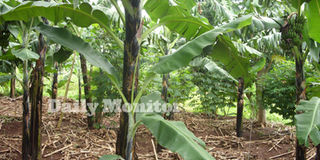M-9 banana variety scores with farmers, consumers

Many banana plantations are beset by challenges of pests, diseases and adverse climatic conditions. Therefore, varieties like the M-9 is highly sought after because of the resistant or tolerance to these challenges. FILE PHOTO
A banana variety released only half a decade ago by National Agricultural Research Laboratories (NARL) Kawanda, which has various attributes farmers and consumers that highly desire, has had unprecedented pace of adoption.
“M-9” (the ninth matooke of the hybrid varieties in a series) or Kabana 6H, is known farmers as Kiwangaazi (meaning long life in Luganda). It is resistant to Black Sigatoka (BS) disease that attacks leaves, tolerant to nematodes and weevils—the two pests that damage stems and roots.
Rapid adoption
Dr. Jerome Kubiriba, the head of NARL’s Banana Research programme, noted that M-9 has rapidly earned interest across the country among farmers, consumers and dealers in banana planting materials—even in the most unexpected places as northern Uganda.
“Since release of M-9 in 2010, there is an amazingly rapid adoption by farmers. It is because of its tolerance to weevils, nematodes and resistance to BS, which are the common challenges that render banana-growing a headache. This is especially in Buganda, Busoga and Busoga sub-regions, where climatic conditions are favourable for these pests and diseases.”
He also revealed that south-western Uganda produces an estimated 12 million tonnes, which is 60 percent of the national output, while the central and parts of the eastern Uganda produce 30 per cent.
“One reason why the Ankole sub-region produces more bananas than other sub-regions is the higher altitude it is located, where temperatures are cooler. Hence unfavourable to breeding, reproduction and multiplication of weevils, nematodes and fungus causing Black Sigatoka disease,” the scientist explained.
The opposite is what pertains to Buganda, Bunyoro and Busoga, which are lower in altitude hence hotter and favourable to weevils, nematodes and BS infestations.
There is a rise in these in the three regions due to global warming, and therefore greater infection of the local banana varieties. Thus M-9, which is resistant/tolerant to the challenges, comes in handy to enable the farmers in Buganda, Bunyoro and Busoga to re-establish their banana plantations that have been affected.
M-9 is also highly sought-after by farmers in northern Uganda especially Lango and Acholi. The two regions have a significant presence of traditional banana-consuming and trading communities, such as Baganda, Bagisu, Batooro, Banyankore and Banyoro, who have settled for business, work in NGOs, central/local governments, and have also inter-married.
Kubiriba says M-9 is performing well in the two regions which are originally non-banana-growing. Traders in northern Uganda traders have good access to markets in Lira, Gulu, Soroti and Mbale towns.
However, he points out that the undoing is banana bacterial wilt (BBW), the top-banana killer disease in the Great Lakes region. “But we have used genetic engineering to introduce BBW-resistance in the M-9 variety. The genes for resistance have been extracted from green pepper and there are good signs of resistance in the early evaluation,” Kubiriba said.
Dr David Talengera, a molecular biologist at NARL, says multi-locational trials of the anti-BBW genetically modified (GM) bananas will be carried out in different agro-ecological regions.
“These multi-locational confined field trials shall be established in Naro’s Bulindi Zonal Research and Development Institute [Bulindi Zardi] and Mbarara Zardi in Hoima and Mbarara respectively.”
The go-ahead for the trials was given by the National Biosafety Committee, the multi-professional and specialists’ body that vets genetic engineering work at Uganda National Council for Science and Technology (UNCST).
On what M-9 looks like compared to ordinary banana varieties, Kubiriba says it bears a big bunch and has excellent cooking attributes—softens and has a sweet aroma. Due to wide-ranging stakeholder interest in, and easy adaptability of, M-9 bananas, NARL is currently applying biotechnology to enhance it with Pro-Vitamin A genes or beta carotene for better nutrition.
More beneficial
Dr Priver Namanya, head of the banana biofortification project at NARL, recently told members of National Farmers’ Forum on Agricultural Biotechnology that the genes were extracted from an Asian banana known as Asupina, and from the African yellow maize.
“The biofortification is aimed at making the banana a more beneficial food so that instead of a consumer gaining only water, starch and carbohydrates, we want to enable Ugandan banana consumers to get Vitamin A, too. Children should especially benefit more, by gaining improved sight and brain development at early age.”
Kubiriba notes conventional and genetic engineering to breed bananas can be used to produce even better products like resistance to BBW.
“Already M-9 has resistance to fusarium wilt, another fungal disease that can reduce yields to zero. It was responsible for wiping out bogoya from the world market. That is why a more resistant variety of banana related to bogoya, called Cavendish was adopted as a quick gap-filling measure but it isn’t as tasty as bogoya.”
What is m-9 variety?
The M-9, is a hybrid between Calcutta—an India-originated banana (which possesses lots of resistance to most tropical pests and diseases) and an East African Highland Banana (EAHB) variety which is among the Ugandan local types.
M-9 was bred by a team led by NARL’s current director, Prof Wilberforce Tushemereirwe, and included scientists from the International Institute of Tropical Agriculture (IITA).




